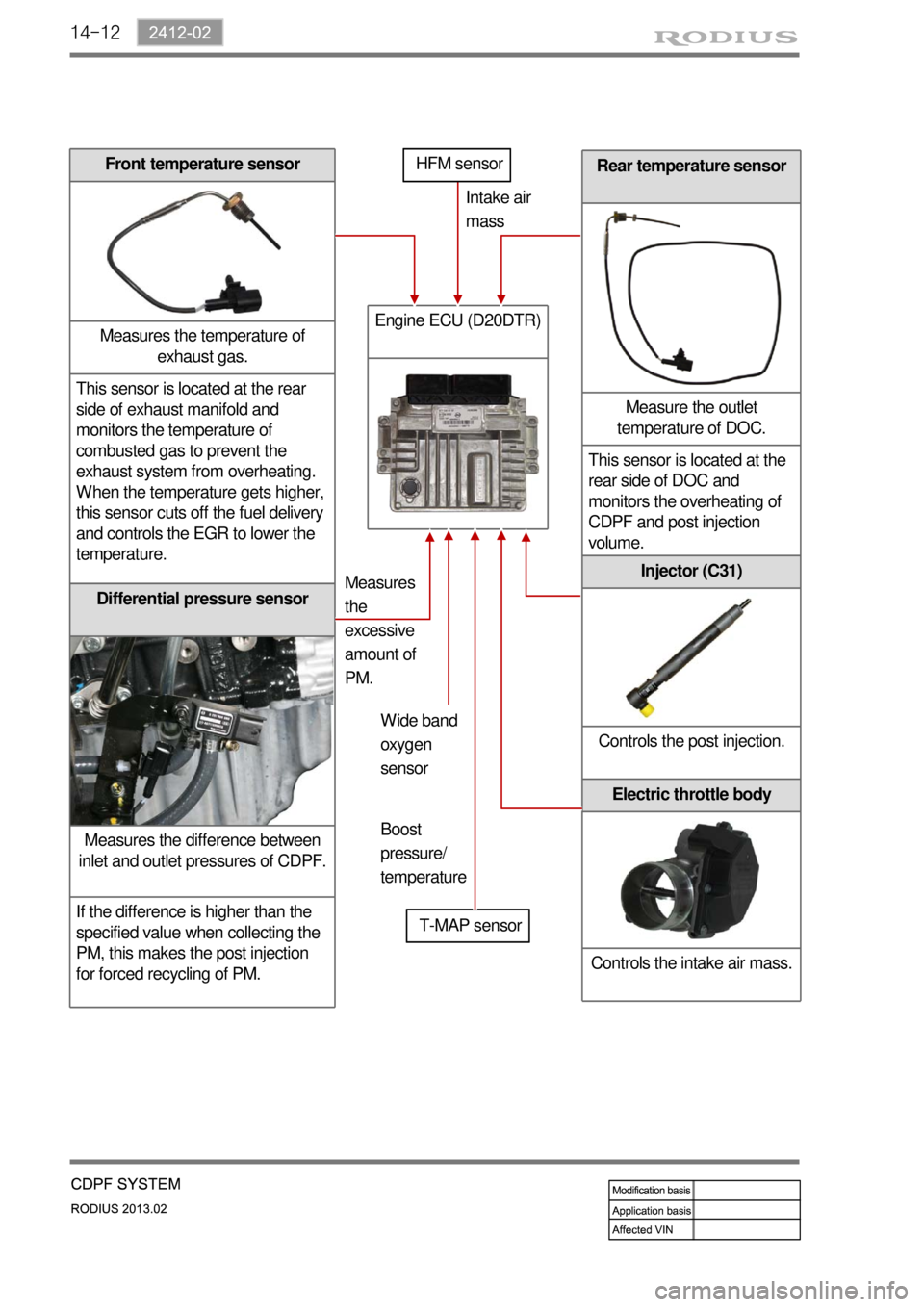Page 271 of 796

07-6
2. FUNCTIONS OF LUBRICATION
1) Lubrication
It creates a viscous barrier between moving parts that reduces friction, which means less heat and
longer life for those parts. As a lubricant, oil must maintain a protective film to prevent metal-to-metal
contact. It must be fluid enough to allow easy starting and to circulate quickly through the engine, yet
remain thick enough at higher operating temperatures and speeds to provide adequate lubrication.
2) Cooling
Combustion heat and friction energy must be removed from the engine in order to prevent its
overheating. Most of heat energy is taken by the engine oil.
Clean oil passages, proper viscosity and low contamination provide sufficient flow rate of the engine oil
and effective cooling.
3) Sealing
It helps to seal the space between the pistons and the cylinder walls so that compression is more
effective and power is not lost during combustion.
4) Anti-corrosion
As a corrosion inhibitor, oil coats internal engine parts to prevent surface rust on the inside of the
engine which can be caused by blow-by products and water formed in combustion. It must also be
capable of neutralizing the acids that are formed by combustion blow-by and oil oxidation at high
temperatures.
5) Cleaning
The small particles of dirt or other contaminants are suspended in oil and carried away to be filtered
out. As a detergent, engine oil must be able to gather and suspend dirt and other contaminants until
the oil can leave them as it passes through the filter and returns to the internal engine environment.
Page 276 of 796

08-71520-00
3. CAUTIONS
If 100% of anti-freeze is added, the water pump vane can be damaged and thermal conductivity
can be decreased resulting in poor circulation in the cooling system which leads to overheated
engine.
Use of non-recommended coolant could cause damage to the cooling system and overheating of
the engine.
Opening the coolant reservoir cap while the engine is running or hot can cause burns by hot
steam or water.
To open the coolant reservoir cap, wrap the cap with a wet towel or thick cloth after the engine is
cooled down sufficiently.
If cool water is added to the heated engine, the engine or radiator can be deformed.
The anti-freeze in the coolant can damage the painted surface, so avoid the contact of the coolant
to the painted body.
The anti-freeze and water should be mixed in proper mixture ratio. Never add only water when
adding coolant.
If the anti-freeze content is too low, the coolant can be frozen while the engine can be overheated
if anti-freeze content is too high. -
-
-
-
-
-
-
-
Page 324 of 796

14-12
Rear temperature sensor
Measure the outlet
temperature of DOC.
This sensor is located at the
rear side of DOC and
monitors the overheating of
CDPF and post injection
volume.
Differential pressure sensor
Measures the difference between
inlet and outlet pressures of CDPF.
If the difference is higher than the
specified value when collecting the
PM, this makes the post injection
for forced recycling of PM.
Front temperature sensor
Measures the temperature of
exhaust gas.
This sensor is located at the rear
side of exhaust manifold and
monitors the temperature of
combusted gas to prevent the
exhaust system from overheating.
When the temperature gets higher,
this sensor cuts off the fuel delivery
and controls the EGR to lower the
temperature.
Engine ECU (D20DTR)
T-MAP sensorIntake air
mass
Measures
the
excessive
amount of
PM.
Injector (C31)
Controls the post injection.
Electric throttle body
Controls the intake air mass.
HFM sensor
Wide band
oxygen
sensor
Boost
pressure/
temperature
Page 391 of 796

05-32420-01
1. OVERVIEW OF EXHAUST SYSTEM
When you are inspecting or replacing exhaust system components, make sure there is adequate
clearance from all points on the underbody to avoid possible overheating of the floor panel and
possible damage to the passenger compartment insulation and trim materials.
Check the complete exhaust system and the nearby body areas and trunk lid for broken,
damaged, missing or mispositioned parts, open seams, holes, loose connections, or othe
r
deterioration which could permit exhaust fumes to seep into the trunk may be an indication of a
problem in one of these areas. Any defects should be corrected immediately. -
2. OVERVIEW OF MUFFLER
Aside from the exhaust manifold connection, the exhaust system uses a flange and seal joint design
rather than a slip joint coupling design with clamp and U-bolts.
If hole, open seams, or any deterioration is discovered upon inspection of the front muffler and pipe
assembly, the complete assembly should be replace, the complete assembly should be replaced.
The same procedure is applicable to the rear muffler assembly. Heat shields for the front and rea
r
muffler assembly and catalytic converter protect the vehicle and the environment from the high
temperatures that the exhaust system develops.
3. OVERVIEW OF CATALYTIC CONVERTER
When jacking or lifting the vehicle from the body side rails, be certain that the lift pads do not
contact the catalytic converter, as this could damage the catalytic converter. -
Use of anything other than unleaded fuel will damage the catalyst in the catalytic converter. -
The catalytic converter are emission-control devices added to the exhaust system to reduce
pollutants from the exhaust pipes.
The oxidation catalyst is coated with a catalytic material containing platinum and palladium,
which reduces levels of hydrocarbon (HC) and carbon monoxide (CO) from the exhaust gas.
The three-way catalyst has coatings which contain platinum and rhodium, which additionall
y
lower the levels of oxides of nitrogen (NOx). -
-